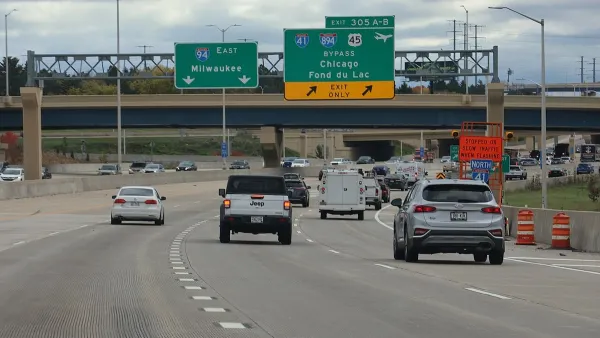A federal court found that the Wisconsin DOT uses specious traffic projections to justify the $146 million widening of Highway 23. The state must now either perform verifiable forecasting or scrap the expansion plans.
State departments of transportation all over the country use specious traffic projections to justify hugely expensive road widening projects. That’s how you end up with the graph below—showing how DOTs continued to forecast traffic growth year after year, even as driving stagnated.
Aggregate traffic projections from the nation’s state and regional transportation agencies have become increasingly divorced from reality. (Source: SSTI)
Wisconsin DOT is perhaps the most notorious manipulator of traffic forecasts. Fortunately, Wisconsin also has a strong network of organizations holding the DOT's feet to the fire and dragging it to court if need be.
Today, 1,000 Friends of Wisconsin Executive Director Steve Hiniker shares news of a major legal victory. A federal court sided with the organization in a suit against WisDOT that challenged the traffic data used to justify the $146 million widening of Highway 23:
According to the ruling, the Wisconsin DOT failed to justify the amount of traffic it projected as likely to use the road in the future. The Court ruled that the project is ineligible for federal funding until documented accurate traffic forecasts can be made that justify expanding the highway. The state can now either go back to the drawing board and do verifiable forecasting or scrap the expansion plans. The ruling does not stop the state from building the project using only state funds.
“We encourage the DOT to immediately make safety improvements along Highway 23 that could always have been done without expanding the highway to 4 lanes,” added Hiniker.
“We call on the legislature to stop funding any road expansion project that has not already begun construction until updated, accurate and verifiable traffic forecasts can be made. The state cannot afford to spend billions of dollars on highway projects that are not justified by accurate data,” concluded Hiniker.
This case could have dramatic ramifications for other highway building plans in the state. Critics of DOT building plans have questioned a number of projects based on faulty traffic projections – including the proposed almost billion dollar expansion of the I-94 corridor near Miller Park in Milwaukee.
FULL STORY: Federal Court: Wisconsin Uses Bogus Traffic Data to Justify Highways

Analysis: Cybertruck Fatality Rate Far Exceeds That of Ford Pinto
The Tesla Cybertruck was recalled seven times last year.

National Parks Layoffs Will Cause Communities to Lose Billions
Thousands of essential park workers were laid off this week, just before the busy spring break season.

Retro-silient?: America’s First “Eco-burb,” The Woodlands Turns 50
A master-planned community north of Houston offers lessons on green infrastructure and resilient design, but falls short of its founder’s lofty affordability and walkability goals.

Test News Post 1
This is a summary

Analysis: Cybertruck Fatality Rate Far Exceeds That of Ford Pinto
The Tesla Cybertruck was recalled seven times last year.

Test News Headline 46
Test for the image on the front page.
Urban Design for Planners 1: Software Tools
This six-course series explores essential urban design concepts using open source software and equips planners with the tools they need to participate fully in the urban design process.
Planning for Universal Design
Learn the tools for implementing Universal Design in planning regulations.
EMC Planning Group, Inc.
Planetizen
Planetizen
Mpact (formerly Rail~Volution)
Great Falls Development Authority, Inc.
HUDs Office of Policy Development and Research
NYU Wagner Graduate School of Public Service




























